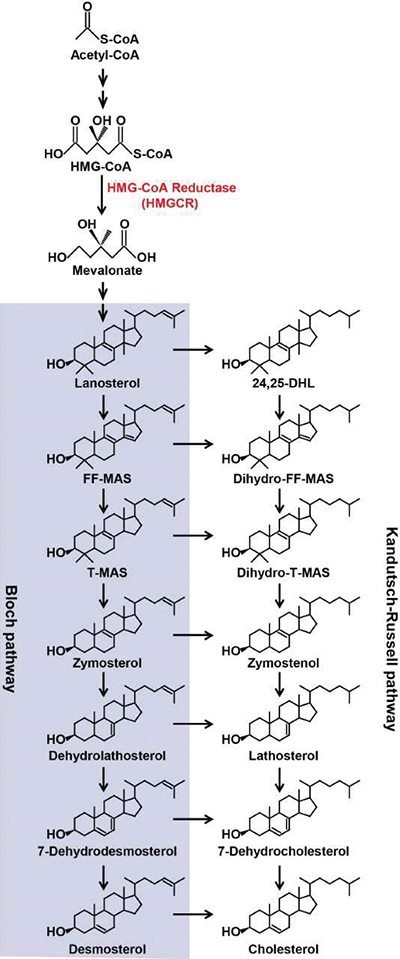JLR: What controls cholesterol biosynthesis?
Homeostasis is an important biochemical principle. The pace of a biosynthetic pathway often is controlled by feedback from pathway products, adjusting the system to prevent excessive accumulation of its products.
 A pathway diagram shows two parallel routes from mevalonate to cholesterol.Bao-Liang Song
A pathway diagram shows two parallel routes from mevalonate to cholesterol.Bao-Liang Song
Cholesterol biosynthesis is one example. Researchers know it is regulated by metabolic intermediates but until now have disagreed about which intermediates do the work. In the Journal of Lipid Research, Liang Chen and colleagues at Wuhan University and the Chinese Academy of Sciences report that several metabolites can affect the activity of two cholesterol biosynthesis enzymes. The study gives new insight into how cholesterol biosynthesis is regulated.
Researchers knew that an intermediate product of the biosynthetic pathway could inhibit each of two control points: HMG-CoA reductase, or HMGCR, which synthesizes a key cholesterol precursor called mevalonate, and sterol responsive element-binding protein, or SREBP, a transcription factor that affects many cholesterol synthesis enzymes.
Data suggested that lanosterol, the first intermediate in the pathway that is cyclic instead of linear, was the key regulator, but the researchers knew that a slightly modified version of lanosterol might be more important. The question is complicated because the cholesterol biosynthesis pathway bifurcates after lanosterol is formed.
In lanosterol or any of its downstream products, a double bond in the molecule’s alkyl tail can be reduced, and the reduced molecules proceed through the same steps to be turned into cholesterol (see figure). So which intermediate cholesterol metabolite exerts the most control over the overall biosynthetic pathway?
That is a technically difficult problem. It is hard to induce accumulation of specific intermediates, because no effective enzyme inhibitors exist for specific steps in sterol synthesis and cells are unlikely to take up exogenously added pathway intermediates.
Chen and colleagues worked around these difficulties by generating a cell line better equipped to absorb mevalonate, a key intermediate produced by HMGCR. In these cells, intermediates can accumulate even if HMGCR activity is blocked. When these cells are provided with mevalonate, they scale up cholesterol production, triggering homeostatic degradation of HMGCR and blocks SREBP activation.
The team then systematically knocked out cholesterol biosynthesis enzymes using CRISPR, forcing traffic to back up immediately upstream of whichever conversion step had been blocked. Using lipidomic analysis of sterol extracts from each knockout cell line, they assessed the impact of loss of each enzyme and accumulation of its substrate, identifying key metabolites that impacted levels of HMGCR and SREBP.
The researchers showed that lanosterol down-regulated HMGCR but not SREBP, confirming that lanosterol and not its reduced relative is the key regulator. They also found that other sterol intermediates with reduced double bonds inhibited both HMGCR and SREBP. The authors say that molecules resembling these endogenous regulators could be a new way to control cholesterol levels.
Enjoy reading ASBMB Today?
Become a member to receive the print edition monthly and the digital edition weekly.
Learn moreGet the latest from ASBMB Today
Enter your email address, and we’ll send you a weekly email with recent articles, interviews and more.
Latest in Science
Science highlights or most popular articles

Immune cells can adapt to invading pathogens
A team of bioengineers studies how T cells decide whether to fight now or prepare for the next battle.

Hinton lab maps structure of mitochondria at different life stages
An international team determines the differences in the 3D morphology of mitochondria and cristae, their inner membrane folds, in brown adipose tissue.

National Academies propose initiative to sequence all RNA molecules
Unlocking the epitranscriptome could transform health, medicine, agriculture, energy and national security.

From the journals: JLR
What can you do with artificial lipoproteins? A new key to angiogenesis. Flavonoids counteract oxidative stress. Read about recent papers on these topics.

Iron could be key to treating a global parasitic disease
A study has found that leishmaniasis causes body-wide changes in iron balance, leading to red blood cell damage.

Environmental DNA is everywhere
The ability to extract trace bits of DNA from soil, water, and even air is revolutionizing science. Are there pitfalls?

